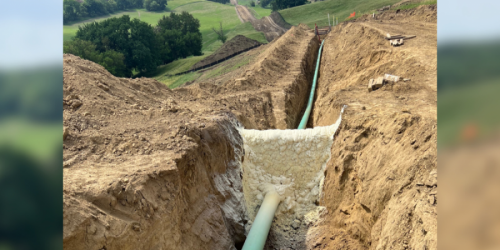Q&A Forums
Temp difference in attic space Post New Topic | Post Reply
| Author | Comments |
|---|---|
|
Posted: Dec 09, 2007 08:45 AM
|
Temp difference in attic space
I had my attic space sprayed with 1.7lb closed foam and created a conditioned attic space. Just had a home energy audit and the inspecter noticed a difference in temp using the thermal gun. The difference was about 5-6 degrees F from eves to the rest of the attic. The eves were cooler. It was explained to me that the eves would be cooler since they are in direct contact with the outside. I asked them to take a reading of the apex of the roof and there was no difference. I said that was open to the outside as well due to a ridge vent. I got the deer in the headlights look. I wanted to here from a 3rd party and see what they think. Any help would be appreciated.Dennis |
|
Posted: Dec 09, 2007 08:53 AM
|
Forgot some info.....the thickness was 2.5" and the gable ends were 2.5" as well Dennis |
|
mason
Posted: Dec 12, 2007 07:28 AM
|
Dennis, There are too many variables to make a determination about the temperature differences in your attic. But some things to check, 1. Is it really 2.5 inches everywhere? Most foamers have some spots that are thicker than others. Even if you have 2.5 inches on average, you might have 4 inches some places and 2.5 inches in other areas. 2. Are there any areas where the foam was not installed? Even a small gap can let in outside air and cause a draft. 3. Is 2.5 inches sufficient? Depending on your climate, I would probably use more foam. I found in cold storage applications that when I installed 2 inches to the outside of a 45 degree cooler that on a 85 degree day with 60% humidity that condensation would occur on the foam. I suspect that you are getting some convection currents in the attic due to the thickness of the foam. In the south, I prefer 3-4 inches in the north 4- 6 inches. |
|
Posted: Dec 12, 2007 06:46 PM
|
Mason, On average there is 2.5 inches. I should say at the minimun there is 2.5". The entire attic space is insulated. There shouldn't be any air gaps up there. I asked about having more foam installed then what they recommended and I was informed that the cost to savings ration would be out of wack. The cost to add more foam would not pay for itself. More foam than the 2.5" would only yield very small amout of effectiveness. These were the reasons the contractor gave me for not going thicker than 2.5". I noticed after a couple of inches of snow we had two weeks ago that the spots that started to melt first on my roof were where the attic joist were. Should I have asked the contractor to spray the entire joist as well?? I feel like they did a good job for the money. I guess I'm asking is more better with the foam. At what point does the cost to saving ration start to go out wack. I don't plan of moving out of this house. Does that effect the cost to saving ratio?? How effective will this amount of insulation be in the summertime. I live in New Jersey close to Philly. Summer are hot and humid and winters can get nasty. Thanks a lot for your help!!! |
|
Posted: Dec 12, 2007 08:56 PM
|
it was fall a year ago i sprayed a conditioned space attic for a contractor freind of mine. he happens to have been an eeba board member and is active in the energy efficient building science community....anyway,, i felt i had to preface so you understand why he is monitering this structure...it is one of a few we are "gathering data" on... this 1970's built home had a 6:12 pitch attic which had the typical cross hatched r19 batts down on the drywall for r38 total,,,it had insulated flexible ductwork laying on the batts throughout the attic...baffles and ridge vents,,,and a gable end vents as i remember... anyway,,,don was worried about some roof sheeting that looked like it didnt like the last 30 years of the constant moisture vapor drive from the inefficient leaking insulation system...so he put down 1"board stock against the sheating and then in came the foamdude and crew and we sprayed 6"...yep,,thats 6" count em,,,1,,2,,3,,4,,5,,6 inches of closed cell urethane over top of the r5 board stock... well,,prior to this installation the bedroom in the northwest corner of the homes second floor was uninhabitable in the dog days of winter (unless you are my ex wife!!)due to the cold... after the installation the attic is 1 1/2 degrees cooler 6" off the peak of the roof(remote temp sensor in place) than the 2nd floor bedrooms which now are 1 degree cooler than the first floor below... anecdotal,,,indeed,,but this is what we are seeing,,consistently,,, more foam than needed??maybe,,but you cant have 50% savings with 50% less rvalue in a wall or roof system,,,but build a wall/roof system with foam and "similar" rvalues and watch the utility meters screech to a halt.... also dennis,,,if you had a conditioned attic space created,,the ridge vent is sealed thus allowing the mechanicals to created a conditioned space....that may explain the deer in the headlite look from the inspector-dude. i hope this helps... |
|
Tim O'Keefe
Posted: Dec 12, 2007 09:20 PM
|
I think you should have requested more foam in the roof deck. 4"-5" would have been better (and meet code). If you have a low pitch it is sometimes hard to reach in and insulate above the eaves because you cannot get the gun perpendicular to the roof deck. This can create a "roll" in the foam which results in a void behind it that is difficult to fill afterwards. You want to insulate that area slowly and very little depth at a time to do it correctly. Run your hand along and see if you can feel any deviations from the rest of the installation. That typically would cause the temperature differential you are seeing. Did they fill in the soffit area above the top plate? Something would need to be placed in there (fiberglass, tar paper, wood, poly iso board) to spray against. This area would need to be spayed the full depth of the rafter cavity and as thick or thicker than the specified amount of foam in the rest of the job. Tim Granite State Spray Foam Co. |
|
mason
Posted: Dec 13, 2007 08:08 AM
|
Thanks Tim and Foamdude for the additional information. I agree that in the case of colder climates that more than 2.5 inches of SPF is desirable (and required by code). When temperatures get below freezing, 4-6 inches of foam will provide much better insulation value. However, you shouldn't need more than that unless you are in subzero temperatures for most of the year. |
|
Posted: Dec 13, 2007 06:24 PM
|
Yes they did fill the cavity between the top plate and the roof. I have a 6-12 pitch so geeting into the eves was still somewhat of a challenge. They did not stuff anything into the area. The only way that I can check to see if it was done correctly is open up the soffit to see. I am noticing a difference in the way the house retains the heat. Thank you everyone for the info!! |
|
Posted: Dec 14, 2007 04:51 PM
|
dons rationale for 6" CC over the 1" boardstock: if the "paper" is out there that shows 4" CC in a cathedralized attic performs "EQUAL TO" 14" of loose fill.... 4" cc = ~R25 14" loose fill =~R40... so with the additional R19 or so of the additional foam products affords INCREASED PERFORMANCE,,, not performance equal to... and don was looking for increased performance wanting to REDUCE his energy bills... he has..substantially |





























